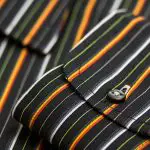Hey there, ever wonder how long tacky glue takes to dry on fabrics?
It's like waiting for a pot of water to boil – you're just staring at it, and it feels like it's taking forever!
But don't worry, I've got the inside scoop for you. Tacky glue usually dries on fabrics within 2 to 4 hours, depending on factors like humidity and fabric type.
If you're in a rush, you can speed up the process by using a hairdryer on a low, cool setting. Just make sure to test the bond before fully using your glued fabric.
Stick around for some handy tips to ensure your fabric gluing project is a success!
Key Takeaways
- Temperature is a significant factor affecting the drying time of tacky glue on fabrics.
- Warmer temperatures lead to quicker drying, while cooler temperatures can prolong the drying process.
- The optimal temperature for efficient drying is 70-77°F (21-25°C).
- Humidity levels in the air can also impact the drying time of tacky glue on fabrics.
Factors Affecting Drying Time
You'll find that the drying time of tacky glue on fabrics can be influenced by several factors.
Temperature is a significant factor affecting the drying time of tacky glue on fabrics. In warmer temperatures, the glue tends to dry more quickly, while cooler temperatures can prolong the drying process. Ideally, working in a room with a temperature between 70-77°F (21-25°C) is optimal for efficient drying.
Humidity also plays a crucial role in the drying time of tacky glue on fabrics. High humidity levels in the air can slow down the evaporation of water in the glue, leading to a longer drying time. Conversely, low humidity can expedite the drying process.
It's important to consider these factors when planning your crafting projects using tacky glue on fabrics. By controlling the temperature and humidity in your workspace, you can manipulate the drying time to better suit your needs.
Understanding how these factors interact with the glue will allow you to achieve the best results for your fabric projects.
Recommended Drying Times
To ensure optimal results for your fabric projects, it's important to adhere to the recommended drying times for tacky glue on fabrics. Control the temperature and humidity in your workspace to manipulate the drying time according to your needs.
- Proper Application
- Apply a thin, even layer of tacky glue to the fabric surface.
- Use a brush or applicator to ensure the glue spreads evenly and penetrates the fabric fibers for a strong bond.
- Allow the glue to set for 5-10 minutes before pressing the fabric pieces together.
- Bond Strength
- For a strong bond, allow the glued fabric to dry for at least 24 hours before handling or washing.
- If the fabric will be subjected to frequent washing or high stress, consider allowing the glue to dry for 48-72 hours to ensure maximum bond strength.
- Test the bond by gently pulling at the fabric pieces to ensure they're securely attached before moving forward with your project.
Adhering to these recommended drying times and proper application techniques will ensure that your fabric projects are durable and long-lasting.
Speeding Up the Drying Process
How can you expedite the drying process of tacky glue on fabrics?
Speeding up the drying process can be achieved by using heat application. After applying the tacky glue to the fabric, you can use a hairdryer on a low heat setting to gently blow warm air over the glued area. Keep the hairdryer at a distance to avoid scorching the fabric or causing the glue to bubble.
The warm air helps to evaporate the moisture in the glue, accelerating the drying time. Alternatively, you can place the fabric in a well-ventilated area and use a fan to increase air circulation, which will also aid in drying the tacky glue more quickly.
Be cautious not to use high heat as it may damage delicate fabrics or cause the glue to dry unevenly. By carefully applying heat, you can significantly reduce the drying time of tacky glue on fabrics, allowing you to complete your project more efficiently.
Testing the Bond
Testing the bond can be accomplished by gently tugging on the glued area to check for any signs of separation. This step is crucial to ensure that the glue has properly adhered to the fabric and formed a strong bond. When testing the bond, consider the following:
- Fabric Tearing: Gently pull on the glued area to see if the fabric tears or if there are any signs of stress. If the fabric tears easily or shows any weakness, the bond may not be strong enough to withstand regular use.
- Bond Flexibility: After tugging on the glued area, observe the flexibility of the fabric. A good bond should allow the fabric to flex and move naturally without any stiffness or resistance. If the fabric feels stiff or rigid, it could indicate that the glue hasn't fully bonded with the fabric fibers.
- Visual Inspection: Examine the glued area closely to look for any visible signs of separation or lifting. If there are any gaps or visible lines where the glue hasn't adhered properly, it may indicate a weak bond that requires reapplication.
Tips for Successful Fabric Gluing
You can achieve successful fabric gluing by ensuring that the fabric is clean and free from any dust or debris. Different fabric types may require different application techniques.
For delicate fabrics such as silk or lace, apply a thin layer of glue and use a gentle pressing motion to avoid damaging the fabric.
For heavier fabrics like denim or canvas, a slightly thicker layer of glue may be needed to create a strong bond.
When working with stretchy fabrics, it's important to stretch the fabric slightly while applying the glue to ensure that it doesn't become too tight once dried.
Additionally, always test the glue on a small, inconspicuous area of the fabric before applying it to the entire surface to ensure compatibility.
It's also essential to follow the manufacturer's instructions for the specific type of tacky glue being used.
Frequently Asked Questions
Can Tacky Glue Be Used on All Types of Fabrics, or Are There Certain Fabrics It Does Not Work Well With?
Tacky glue can generally be used on a variety of fabrics, but it may not work well with certain delicate or loosely woven fabrics. To ensure adhesive strength, test it on a small area first.
Is Tacky Glue Washable After It Has Dried on Fabric, or Will It Come off in the Wash?
Tacky glue is washable after drying on fabric. However, it's essential to let it cure for 24 hours before washing for maximum durability. Proper application technique and allowing adequate drying time are crucial for successful results.
Can Tacky Glue Be Used on Fabrics That Will Be Exposed to Outdoor Elements, Such as Rain or Sunlight?
If you're using tacky glue on fabrics exposed to outdoor elements, consider its durability. Tacky glue can be used on various fabric types, but it may not withstand heavy rain or prolonged sunlight.
Are There Any Special Precautions or Considerations to Keep in Mind When Using Tacky Glue on Delicate or Sheer Fabrics?
When using tacky glue on delicate or sheer fabrics, take special precautions. Consider fabric types, compatibility, and adhesion. Be aware of any limitations and always follow the manufacturer's instructions for best results.
How Does Tacky Glue Hold up Over Time on Fabrics, Especially With Frequent Washing or Wearing?
With frequent washing, tacky glue may lose its adherence over time on fabrics. Longevity and durability depend on the type of fabric and application. To ensure lasting results, follow the manufacturer's recommendations and consider handwashing delicate items.
- Why Is Red Velvet Not Red? - April 25, 2024
- How Do You Describe Velvet Fabric? - April 25, 2024
- How Strong Is Velvet? - April 25, 2024







